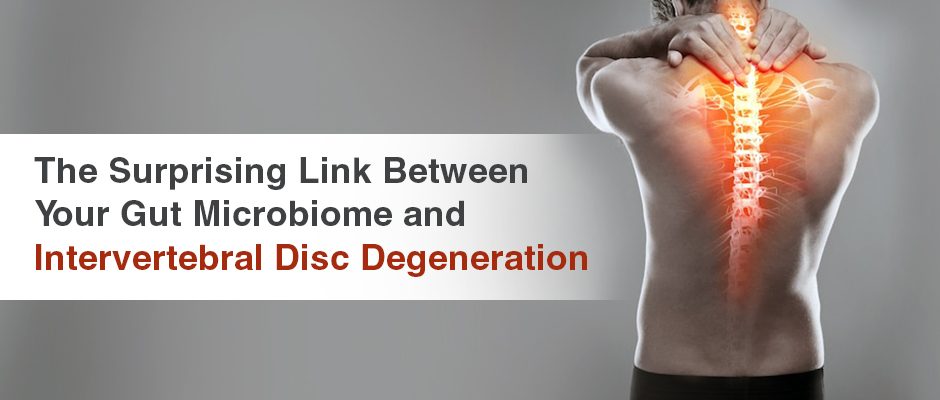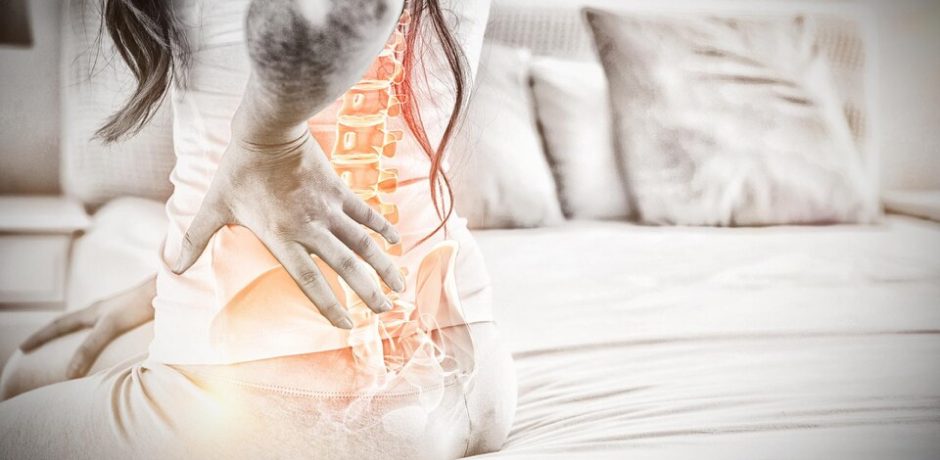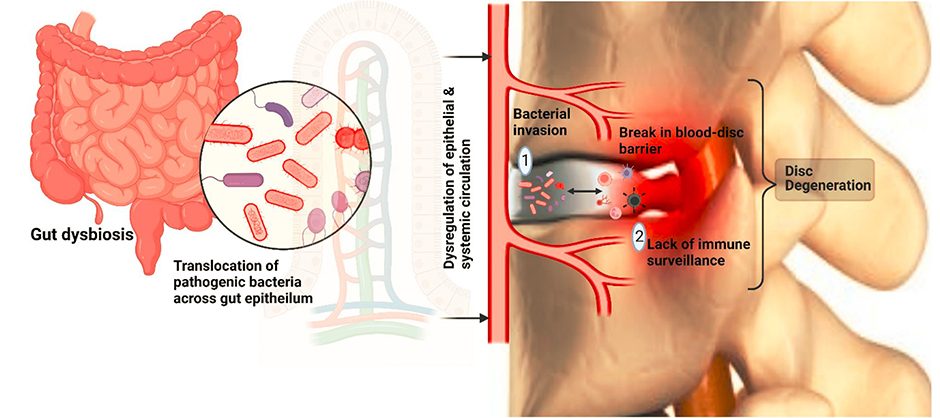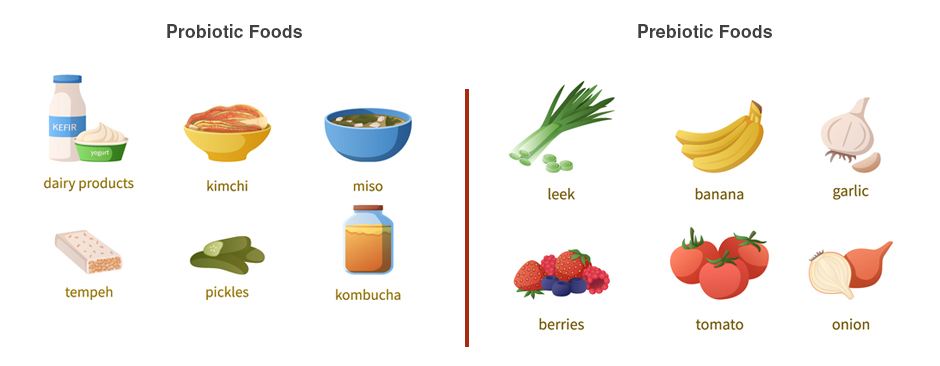September 29, 2023

Holistic practitioners have always known that the body’s systems are all interconnected, and that treating symptoms is not the same as healing patients. Over the past decade, mounds of research have emerged about the gut microbiome and its role in human health, earning it the moniker “Second Brain” for its influence over multiple systems.
Now, exciting new research has linked the gut biome to intervertebral disc degeneration, shining a new light on the mechanisms of low back pain.
Your spinal vertebrae are protected and supported by intervertebral discs (IVDs) — complex spongy elastic structures that help to mediate force loads and absorb shock when your body is in motion.
Discs enable your spine to flex and rotate during physical activity. Their function relies on their ability to deform in response to stress and return to their original shape. The capacity of a disc to deform depends on its state of fluid content. Disc dehydration — aka desiccation — is a primary feature of degenerative disc disease.

Healthy IVDs are about 7-10 cm thick, and lumbar IVDs are about 4 cm in diameter. In healthy individuals, IVDs make up about one-third of total spinal length. The discs are spongy and elastic, with a thick fibrocartilaginous outer ring called the annulus fibrosus, surrounding a gelatinous core called the nucleus pulposus. The nucleus pulposus is made up of 60% collagen, and is sandwiched between cartilaginous end-plates (CEPs).
Healthy IVDs rely on balanced tensile forces from muscles and fascia to hold the vertebrae in optimal alignment. They also rely on certain nutrients and adequate hydration to maintain their structural and functional integrity.
While disc degeneration is often associated with aging, lifestyle factors play a key role in how well your discs age, and making poor lifestyle choices can contribute significantly to the degeneration of lumbar intervertebral discs.
Lifestyle factors that contribute to disc degeneration include:

Disc degeneration occurs when the discs begin to dry out, losing their spongy elastic properties and narrowing the gap between vertebrae. The exterior ring of dry IVDs can easily tear or crack, causing the inner contents to bulge out of place, and compressing spinal nerve roots. Degenerative disc disease can cause pain, numbness and weakness anywhere along the spine, and in appendages affected by spinal nerve compression.
Some disc degeneration is generally thought to be inevitable as we age, but you can slow disc degeneration by staying physically active, maintaining a healthy weight, staying hydrated and eating a diet rich in collagen-promoting foods.
Foods that promote collagen synthesis include:
The gut microbiome is an environment of microorganisms that reside in the human gastrointestinal tract, composed of bacteria, archaea, viruses and eukaryotic microbes.
Microbes and bacteria significantly impact human physiology by:

Your intestines are lined with a single layer of epithelial cells, linked together by tight junction (TJ) proteins. The gut epithelial layer provides a protective barrier between your gut and your bloodstream, keeping harmful bacteria from entering your circulatory system. When your gut becomes dysbiotic, the epithelium can become permeable, allowing gut bacteria to leak into your bloodstream — a condition commonly called leaky gut syndrome.
A suboptimal gut biome has been linked to multiple health conditions, including:
The impact of gut dysbiosis on so many aspects of human health has prompted new research that suggests a direct link between dysbiosis in the gut environment and Intervertebral disc degeneration.
Until recently, the IVD system was thought to be a sterile environment, uniquely protected from inflammatory responses of the immune system. However, new technologies have enabled researchers to identify the presence of microbes in IVDs, with 32 species of bacteria unique to healthy IVDs. Those bacteria are thought to serve as a protective barrier against inflammation and infection.
It is postulated by Li et al. (2022) that certain gut microbes are able to gain access to IVDs via three mechanisms of the gut-disc axis:

The invasion of gut microbes into the IVD system can cause rapid bacterial multiplication due to lack of immune surveillance in IVDs, and low levels of oxygen. The invading bacteria release proinflammatory factors that recruit more inflammatory cells, causing the growth of blood vessels in the IVD system and destroying the IVDs’ anaerobic (low oxygen) environment. This in turn can cause inflammation in the lower back that irritates nerves and causes pain.
In addition, loading and injury to the IVDs can cause microfractures, creating pockets in damaged IVDs where bacteria can thrive and reproduce, increasing inflammation and the risk of infection. Inflammation and infection surrounding IVDs in the lower back are thought to be key links between gut dysbiosis and low back pain.
As a related side note, a growing body of evidence suggests that people with chronic low back pain also experience accelerated cognitive decline that can lead to dementia. Scientists have linked microbiota dysbiosis to neuroinflammation in the brain that may cause cognitive decline. Researchers are now investigating the gut-brain axis to learn more about how gut health and chronic low back pain are related to cognition.
Given the many health implications of a dysbiotic gut, it is clear that addressing your gut issues can play an important role in optimizing your health. Luckily, there are many things you can proactively do to begin cultivating a healthy gut microbiome without medical intervention.
1. Avoid processed foods
If most of your daily dietary intake involves prepared, packaged and canned foods, you may be setting your gut up for dysbiosis. Highly processed foods are “dead,” meaning they do not contain live enzymes and bacteria that contribute to a healthy microbiome. Instead, they provide empty calories that are quickly absorbed and lead to obesity, while depriving your body of essential nutrients. According to one new study, a diet consisting of mostly processed foods can literally starve essential microorganisms in the colon, undermining your gut health.
2. Consume foods and beverages that promote gut health
There are many foods and beverages that contain probiotics — live microorganisms that nourish and promote a thriving microbiomic environment.
Probiotic foods include:
You should also consume prebiotic foods — such foods bypass the small intestine to be fermented in the colon, where they feed your gut microbiota.
Prebiotic foods include:

In addition, there is growing evidence that a high-fat, low carbohydrate ketogenic diet promotes a healthy gut biome while combating obesity and metabolic disorders.
3. Avoid certain medications
Antibiotic medications – along with heart medications like proton-pump inhibitors, anti-diabetic drugs, and statins – dramatically alter the gut microbiome. When the balance of microbes in the gut becomes dysbiotic, it can create a downward spiral that exacerbates your health condition. While antibiotics have their place in combating bacterial infections, they effectively kill your gut microorganisms. Antibiotics should be used rarely. Once your infection is gone, you should immediately replenish your gut microbiome with probiotic foods and supplements.
4. Exercise regularly
Regular exercise keeps your body’s systems working the way they were designed to function. Exercise promotes heart health and fights metabolic disorders like hypertension, diabetes and obesity. Exercise has been shown to promote healthy gut bacteria, reduce systemic inflammation, and support immune function. Simply walking 30 minutes a day can have a positive effect on your gut microbiome and your overall health.
5. Stay hydrated
A healthy human body is made up of 65-70 percent water, and a healthy brain is 80 percent water. All of your body’s systems and structures need water to function properly. Water helps you flush out waste and toxins that can compromise your gut health. Good hydration supports a healthy spine and spongy IVDs. Drinking one ounce of pure mineral water per kilogram (2.2 pounds) of body weight daily can help keep your body adequately hydrated for optimal health. Adding a pinch of himalayan salt to your water can help maintain electrolyte levels.
People suffering from low back pain are often at a loss for solutions to eliminate it. Medical doctors often recommend bed rest, and prescribe anti-inflammatory drugs, steroid injections and narcotic pain medications. However, those measures only treat your symptoms without addressing the underlying problem.
Patients often become frustrated when MRI results fail to show any mechanical issues that can be blamed for low back pain, not understanding that their pain can be caused by other non-mechanical factors. When all else fails, back surgery becomes a last resort, often rendering dubious outcomes that sometimes make the condition worse.
At NYDNRehab, we take a holistic approach to low back pain treatment. We believe in treating the patient, not just their symptoms. Our end goal is to eradicate the root cause of low back pain, without drugs or surgery.
We use the highest resolution diagnostic ultrasound to visualize the structures of the spine in motion, to rule out mechanical problems. We consider lifestyle factors that contribute to low back pain, and educate our patients on how to make positive changes. Our regenerative technologies are second to none in alleviating pain and inflammation, and promoting healing.
You don’t have to live with chronic low back pain that deteriorates your health and keeps you from doing the things you love. Contact NYDNRehab today, and get the help you need to fight Intervertebral disc degeneration and stop low back pain in its tracks.
Dr. Lev Kalika is a world-recognized expert in musculoskeletal medicine. with 20+ years of clinical experience in diagnostic musculoskeletal ultrasonography, rehabilitative sports medicine and conservative orthopedics. In addition to operating his clinical practice in Manhattan, he regularly publishes peer-reviewed research on ultrasound-guided therapies and procedures. He serves as a peer reviewer for Springer Nature.
Dr. Kalika is an esteemed member of multiple professional organizations, including: